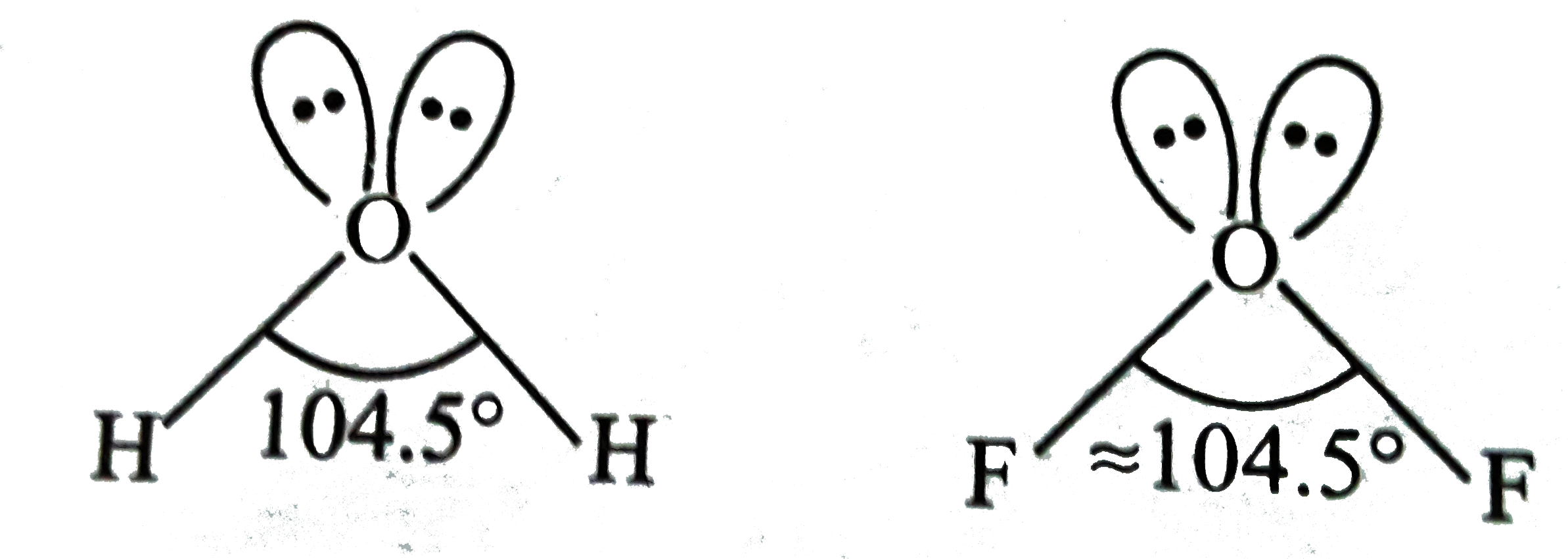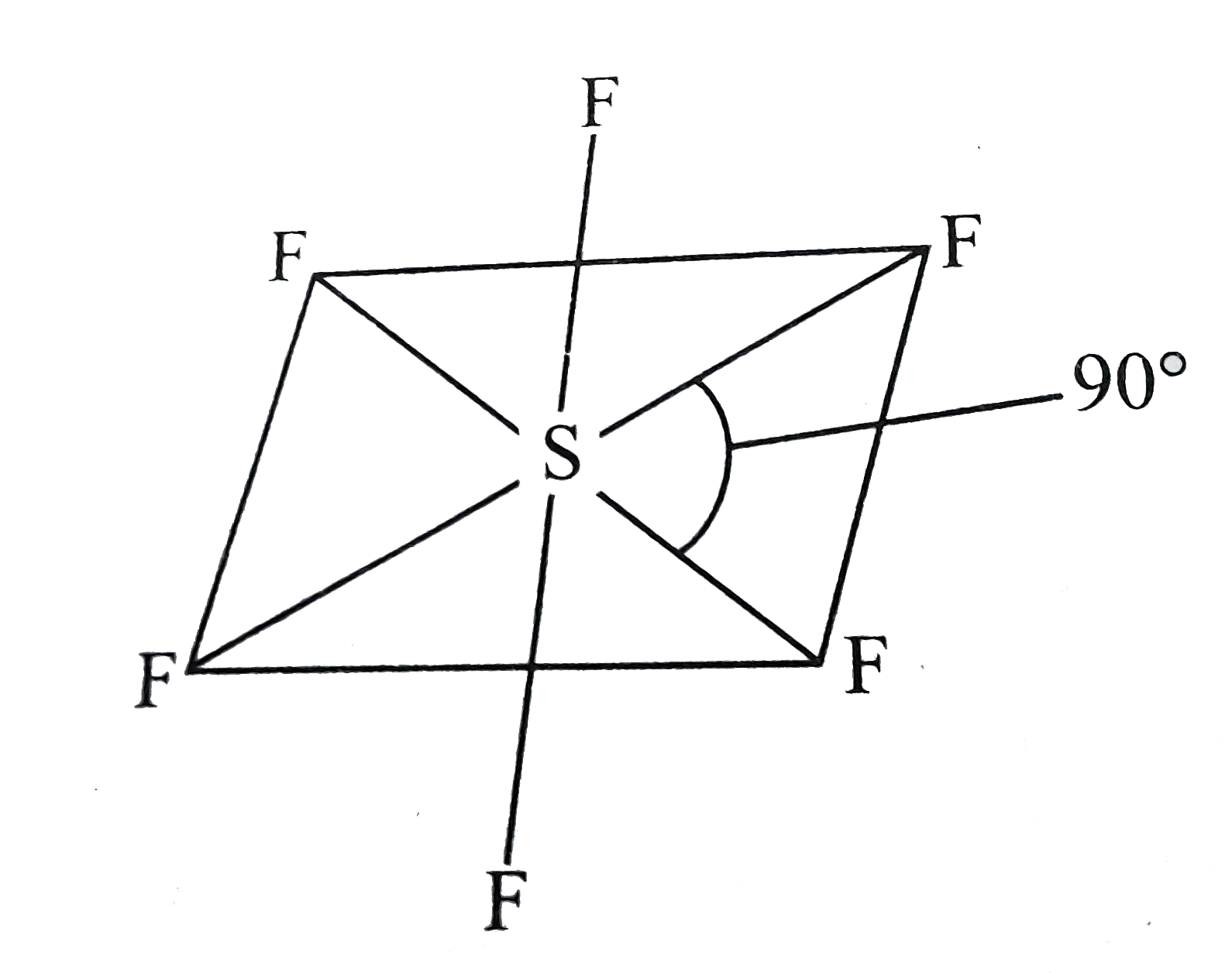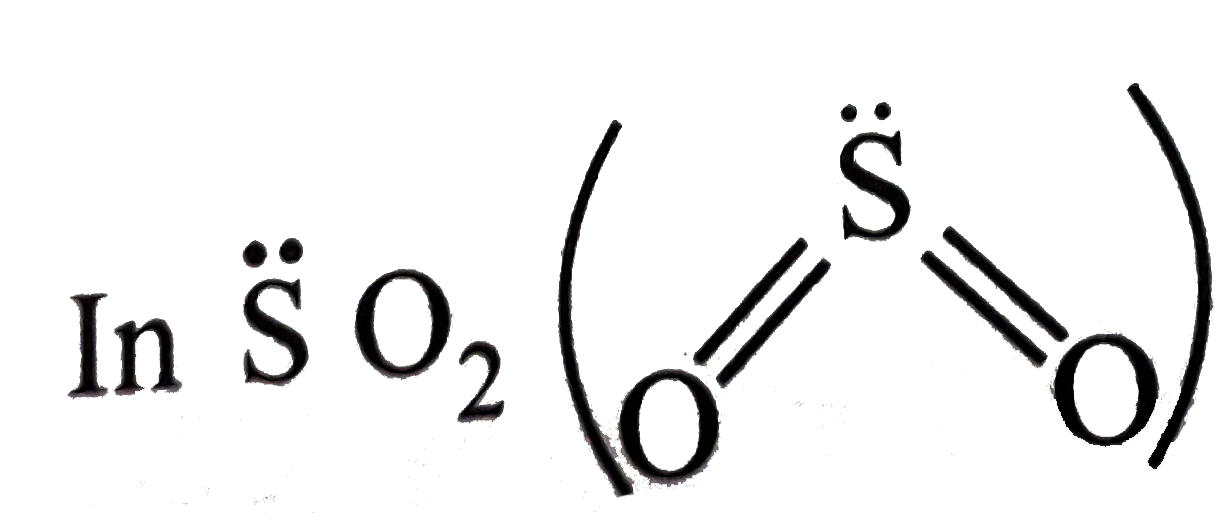In which of the following triatomic molecules, the observed bond angle is 116∘,49' ?
a. H2O b. OF2 c. CO2 d. O3
II. In which of the following molecules, bond angle is the maximum?
a. BeBr2 b. H2O c. H2S d. CH4
III. In which of the following molecules, bond angle between two adjacent covalent bonds is smallest?
a. BeH2 b. BF3 c. NH3 d. CCl4
IV. Bond angle (H−S−H) in H2S is close to
a. 109∘ b. 107∘ c. 105∘ d. 90∘
V. The hybridisation of B in BF3 is sp2. The bond angle in BFɵ4 will be
a. 107∘ b. 109∘ c. 120∘ c. 120∘ d. 180∘
VI. Which of the following molecules contains a bond angle which is smaller than the bond angle in CH4?
a. SF6 b. SO2 c. O3 d. ⊕NH4
Video Solution
Text Solution
for (a) and (b): H2..O.. and ..O..F2 both are molecules in which O-atom is sp3 hybridised. Due to (lp−lp),(lp−bp) and (bp−bp) repulsion, the bond angle is close to 104∘.

c. In CO2,C is sp hybridised and it is linear molecule with bond angle of 180∘.

d. Only in O3, bond angle is close to 116∘49', because the central O atom is sp2 hybridised. Hence the answer is (d).

II (a)
a. In BeCl2,Be is sp hybridised and it is linear molecule so the bond angle is =180∘.

b. In H2..O:,O is sp3 hybridised and due to repulsion between (lp−lp),(lp−bp) and (bp−bp), the bond angle is 104.5∘.
c. In H2..S:,S is sp3 hybridised but according to rule (i), the bond angle is 92.3∘.
d. In CH4,C is sp3 hybridised, since there is no long pair of electrons, thus only (bp−bp) repulsions. Hence the bond angle is 109∘28'.
Thus the answer is (a).
III (c)
a. Be H2 is linear, the bond angle is 180∘.
b. BF3 is trigonal planar, the bond angle is 120∘.
c. In ..NH3,N is sp3 hybridised and due to greater repulsion between (lp−bp) and (bp−bp) the bond angle is reduced to 107∘.
d. In CCl4,C is sp3 hybridised, the bond angle is 109∘28' as explaines above for CH4.
IV (d) : Refer to Section 1.17, Point 3(a).
V (b): In BFɵ4,B is sp3 hybrdised and the bond angle is 109∘28'.
VI (a)
a. In SF6,S is sp3d2 hybridised having octahedral shape, each bond angle is 90∘.

In ..SO2  , S is sp2 hydridised but due to greater repulsion between (lp−bp) and (bp−bp), the angle is reduced to 118∘.
, S is sp2 hydridised but due to greater repulsion between (lp−bp) and (bp−bp), the angle is reduced to 118∘.
c. O3 is sp2 hybridised and the bond angle is 116∘ as explained above in Illustraction 1.54 (I) (d).
d. ⊕NH4 is sp3 hybridesied, since due to the adsence of lone pair electrons on N atom, thus only (bp−bp) repulsions, so bond angle is 109∘28'.
Hence the answer is (a).
|
Topper's Solved these Questions
- PERIODIC CLASSIFICATION OF ELEMENTS AND GENERAL INORGANIC CHEMISTRYBOOK - CENGAGE CHEMISTRYCHAPTER - PERIODIC CLASSIFICATION OF ELEMENTS AND GENERAL INORGANIC CHEMISTRYEXERCISE - Solved Examples
34 Videos
- PERIODIC CLASSIFICATION OF ELEMENTS AND GENERAL INORGANIC CHEMISTRYBOOK - CENGAGE CHEMISTRYCHAPTER - PERIODIC CLASSIFICATION OF ELEMENTS AND GENERAL INORGANIC CHEMISTRYEXERCISE - Ex 1.1
14 Videos
- P-BLOCK GROUP 14 - CARBON FAMILYBOOK - CENGAGE CHEMISTRYCHAPTER - P-BLOCK GROUP 14 - CARBON FAMILYEXERCISE - Exercises Archives (Subjective)
9 Videos
- PURIFICATION OF ORGANIC COMPOUNDS AND QUALITATIVE AND QUANTITATIVE ANALYSISBOOK - CENGAGE CHEMISTRYCHAPTER - PURIFICATION OF ORGANIC COMPOUNDS AND QUALITATIVE AND QUANTITATIVE ANALYSISEXERCISE - Assertion Reasoning Type
5 Videos
Similar Questions
Knowledge Check
Which of the following molecules have both covalent and coordinate bonds ? a)O3 b)N2O c)NH+4 d)H2O
A(a) and (b) onlyB(b) and ( c) onlyC(a), (b) and ( c) onlyDall of theseBond angle in H2O is
A104.5∘B120∘C109.5∘D107∘Which of the following is the correct order of bond angle in H2S, NH3, BF3 and SiH4?
AH2S<NH3<BF3<SiH4BNH3<H2S<SiH4<BF3CH2S<NH3<SiH4<BF3DH2S<SiH4<NH3<BF3
Why is the H-O-H bond angle in H2O smaller than H-N-H bond angle in NH3?
View SolutionThe angle between two covalent bonds is maximum in ……..(CH4,H2O,CO2)
View SolutionThe angle between two covalent bonds is maximum for (CH4,H2O,CO2) ______ .
View SolutionThe O−O−H bond angle in H2O2 is
View SolutionThe bond angle in H2O (for H-S-H) is
View Solution
